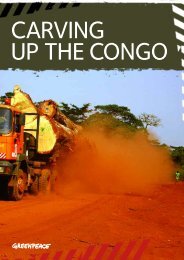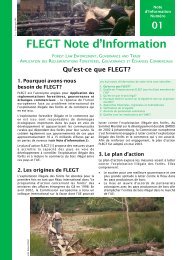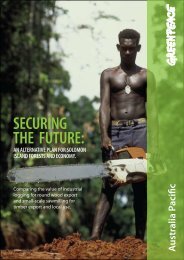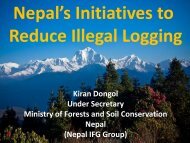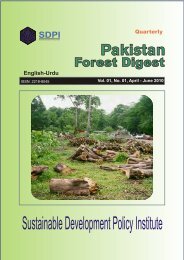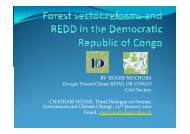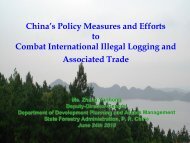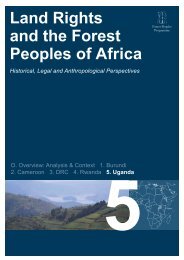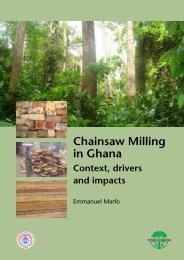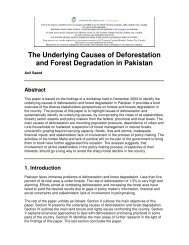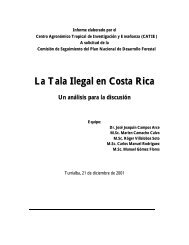chainsaw milling and lumber trade in west africa project
chainsaw milling and lumber trade in west africa project
chainsaw milling and lumber trade in west africa project
Create successful ePaper yourself
Turn your PDF publications into a flip-book with our unique Google optimized e-Paper software.
household activity <strong>and</strong> economic reliance on <strong>cha<strong>in</strong>saw</strong> <strong>mill<strong>in</strong>g</strong> (objective 3). The <strong>in</strong>formation will helpscale up the results.It looks like we made need to work <strong>in</strong> a mim<strong>in</strong>um of 9 communities <strong>in</strong> Ghana (each status type<strong>in</strong> each of the three regions = 3 x 3 =9). To have an adequate estimate of variability with<strong>in</strong> eachcommunity, a target sample size may be 40 households, giv<strong>in</strong>g us a total of 360 households. If it isnecessary to reduce the total sample size, it would be better to reduce the number of householdssampled with<strong>in</strong> a community rather than reduce the number of communities sampled because theexpectation is that the variability <strong>in</strong> community-based or location factors will be more important <strong>in</strong>expla<strong>in</strong><strong>in</strong>g variability <strong>in</strong> the costs <strong>and</strong> benefits accru<strong>in</strong>g to rural people than are the household factors.If the community managed forests are to be <strong>in</strong>cluded, they would be <strong>in</strong> addition to the above 9; ifvillages with a migrant farmer population are to be <strong>in</strong>clude, they would also be <strong>in</strong> addition to the 9.Sample size – how will we determ<strong>in</strong>e when we have a sufficient sample? For the costs <strong>and</strong>benefits, with<strong>in</strong> a community, when you have stop gett<strong>in</strong>g new <strong>in</strong>formationThe questionnaires /semi-structured <strong>in</strong>terviews will be used to solicit <strong>in</strong>formation on current <strong>and</strong>historical <strong>in</strong>formation on household resource use, sources of <strong>in</strong>come, physical <strong>and</strong> non-physical assets,family demographics <strong>and</strong> migration, environmental conditions, changes, shocks or uncontrollableevents that have <strong>in</strong>fluenced the livelihood options.There will be sections of the questionnaire dedicated to the follow<strong>in</strong>g aspects:Household attributes / family members / assets /Community-level attributes / forest or tree resource / governance structureBenefits associated with forests, logg<strong>in</strong>g <strong>and</strong> <strong>mill<strong>in</strong>g</strong> (<strong>in</strong>clud<strong>in</strong>g economic reliance)Costs associated with forests, logg<strong>in</strong>g <strong>and</strong> <strong>mill<strong>in</strong>g</strong>Attitudes around forest resource management <strong>and</strong> protection (of the household, <strong>and</strong> thehousehold’s perspective of the wider community, of the chief <strong>and</strong> assemblyman – thelater might need to be confirmed by triangulation)Conditions necessary to make <strong>cha<strong>in</strong>saw</strong> <strong>mill<strong>in</strong>g</strong> socially susta<strong>in</strong>able? (would it be worth try<strong>in</strong>gto <strong>in</strong>corporate a section for only those households that are directly <strong>in</strong>volved to ask themto rank the changes that need to be made to make <strong>cha<strong>in</strong>saw</strong> <strong>mill<strong>in</strong>g</strong> more useful fortheir livelihoods?)Data AnalysisA profile of the households <strong>in</strong>terviewed will be developed by summariz<strong>in</strong>g household attributesacross the regions <strong>and</strong> forest status types. The types of costs <strong>and</strong> benefits associated with the twotypes of <strong>mill<strong>in</strong>g</strong> activities will be described <strong>and</strong> compared qualitatively. The proportion of householdsrealis<strong>in</strong>g each type of cost <strong>and</strong> benefit will be calculated <strong>and</strong> summarized by community. The extent ofhousehold activity <strong>in</strong> logg<strong>in</strong>g <strong>and</strong> <strong>mill<strong>in</strong>g</strong>, whether small scale <strong>cha<strong>in</strong>saw</strong> operations or large scaleoperations will be calculated as the number of households <strong>and</strong> proportion of households <strong>in</strong>terviewed.Economic reliance is def<strong>in</strong>ed as the relative importance of a particular activity as an <strong>in</strong>comesource or a form of <strong>in</strong>surance. We will calculate economic reliance by household on 1) large-scalelogg<strong>in</strong>g <strong>and</strong> <strong>mill<strong>in</strong>g</strong>, 2) small-scale <strong>cha<strong>in</strong>saw</strong> <strong>mill<strong>in</strong>g</strong>, 3) forest product use. We compared the meaneconomic reliance among the three regions (<strong>west</strong>, central, east) <strong>and</strong> by the status of the forest(protected, managed, farml<strong>and</strong>) us<strong>in</strong>g analysis of variance.A multivariate analysis will be used to identify the variables that are more strongly associatedwith household activity <strong>and</strong> economic reliance on large-scale logg<strong>in</strong>g <strong>and</strong> <strong>mill<strong>in</strong>g</strong>, small-scale <strong>cha<strong>in</strong>saw</strong><strong>mill<strong>in</strong>g</strong>, <strong>and</strong> forest product use. Bivariate correlation analyses will be conducted on pairs of variables todescribe the strength of associations amongst variables. (We could also use regression analyses to dothis, the characteristics of the data will determ<strong>in</strong>e what approach is more appropriate).PART TWO – Cha<strong>in</strong>saw Mill<strong>in</strong>g FirmsAim <strong>and</strong> objectives• To exam<strong>in</strong>e the economics of <strong>cha<strong>in</strong>saw</strong> logg<strong>in</strong>g <strong>and</strong> <strong>lumber</strong><strong>in</strong>g <strong>and</strong> the environmental <strong>and</strong>ecological impacts as they compare with large scale operations;• To characterise the distribution of costs <strong>and</strong> benefits with<strong>in</strong> a firm• To characterise the variability <strong>in</strong> costs <strong>and</strong> benefits across firms




